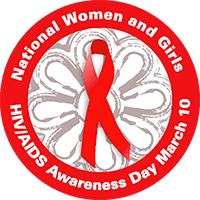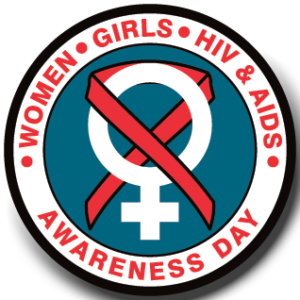
March 10th this year marks the 20th anniversary of the National Women and Girls HIV/AIDS Awareness Day (NWGHAAD). Launched 25 years after the start of the AIDS epidemic by the U.S Department of Health and Human Services’ Office on Women’s Health, NWGHAAD was created to increase the knowledge about and reduce the impact of HIV on women and girls.
Why is NWGHAAD so important? Women and their children were invisible in the early years of the epidemic and few survived. Testing for and research on women with HIV/AIDS was almost non-existent so diagnosis and treatment specifically for women was made difficult. Today, one in four people in the United States with HIV is female. Although that is a statistically large number, women face a number of gender-based inequalities that translate to lack of access to health care, services, and resources, resulting in women, their children and later younger girls being deeply impacted by these societal and structural barriers.
HOCC (Healing Our Community Collaborative) has been in the lead in Massachusetts since 2005 as one of the pioneer organizations connected to the efforts of the Office on Women’s Health (OWH), the organization responsible for creating National Women and Girls HIV/AIDS Awareness Day. OWH brought and has continued to bring organizations and communities together to help women and girls protect themselves from HIV through prevention, testing and treatment; HOCC has been doing just that since 1997.
As we reflect on those earliest days of the epidemic, we add a very personal note about one of HOCC’s current Board members, Leah. Leah was born in 1980 in San Diego, California and may have been one of the first female infants born perinatally infected (mother to child). She moved to Boston (with her parents who were both living with HIV) in 1981 to start her health care at Children’s Hospital for an undefined illness. She was diagnosed with AIDS in her infancy, and now lives well with HIV for 44 years. (Equity of Voices Series: Leah’s Story) https://www.youtube.com/watch?v=zsyXYUoTM2E
Simultaneously, in 1981 the first case of GRID (Gay-Related Immune Deficiency) which was later referred to as AIDS, reported that five women were also among those diagnosed. By the end of 1981, women accounted for 8% of new infections. By early 1982, health experts were becoming “concerned” that transmission through heterosexual contact, transmission to newborns, or transmission through the blood supply could occur – in fact, in 1982, the CDC reported the first infant born with HIV. On January 7, 1983, the CDC reported the first cases of AIDS in women. The underreporting of women and their children had a direct negative impact on prevention strategies, treatment options, research participation opportunities, resources, and all services for women.
By 1987, women represented 7% of all documented AIDS cases in the United States, but only 13.5% National Institutes of Health (NIH) money was dedicated to women’s health issues. By the end of that year, the U.S. Public Health Service issued the first recommendations for preventing HIV transmission from mother to child. In 1988, women were named as the fastest growing population with HIV. Two years later, in 1990, the National “Speak Out” by women with AIDS was held in Washington, DC to protest the Social Security definition of disability, which discriminated against women and people of color. Later in 1991, women living with AIDS had more trouble getting government disability payments than men because the standard definition of AIDS did not consider many of the symptoms experienced by women, therefore not “qualifying” them to receive SSDI even with an AIDS diagnosis.
Finally, by the end of 1993, the CDC expanded the definition of AIDS to include bacterial pneumonia, TB, stage III cervical cancer, and recurrent vaginal candidiasis (yeast infections) as symptoms of HIV. This was a real victory for women living with HIV/AIDS. Additionally, once excluded from all HIV/AIDS research and studies the NIH Revitalization Act now required NIH and other research agencies to expand involvement of women and minorities in all research. In the same year, women now accounted for most of all new HIV/AIDS cases diagnosed in the United States. Still, resources allotted to women for research, health services, education, and outreach remained woefully inadequate.
The good news is that the annual number of diagnoses of perinatal HIV in the United States had declined by more than 95% since the early 1990s.
More than a decade later, according to the CDC in 2004, 27% of all AIDS cases in the US occurred in women, compared with only 7% in 1985. Women of color, especially African-American and Hispanic women, accounted for the great majority of new cases among women. Younger women and girls were particularly vulnerable: females accounted for 38% of all persons younger than 25 years who were given a diagnosis of HIV infection or AIDS between 2001 and 2004, compared with 27% of persons 25 years and older. By the end of 2004, HIV became the leading cause of death for black women aged 25-34 and the third leading cause of death for black women.
The beginning of the invisible decades of the HIV/AIDS epidemic for women, their children and young girls was beyond challenging but deadly. Today, funding for women and girls is difficult and has mostly shifted to other at-risk populations. More good news is the CDC is more inclusive of all people at risk for HIV and recommends HIV testing for everyone at least once in their lives. There were an estimated 34,800 new HIV infections in the US in 2019; 18% or 6,400 were women. The goal for the United States is to reduce the number of all new infections to 3,000 by 2030. Statistics by sex are based on the gender assigned at birth. The most common way that women acquire HIV is through sex with a male partner who has HIV without using a condom. Women are at greater risk of acquiring HIV through vaginal or anal sex because receptive sex is higher risk than insertive sex.3,4,5.
HIV statistics after 2019 may not be accurate due to the COVID pandemic, which likely affected the testing of HIV and the collection of many health statistics, including HIV incidence and prevalence. In turn, there appears to be another shift in the HIV statistics. In 2021, it is reported one in four people living with HIV in the United States is a woman and 30.2% of all new HIV infections in Massachusetts were women. This apparent shift in the numbers of women currently becoming infected and at risk for HIV also lends a wider lens to see how women and men have very different experiences, health outcomes, and health challenges living with HIV. Lack of financial supports, social barriers such as racism, discrimination, and HIV stigma have a major impact on health and well-being. These factors continue to prevent some women from seeking and receiving high-quality health care, including HIV testing, treatment, and other prevention services. Addressing these barriers and encouraging safe and supportive communities can help improve health outcomes for women and girls. This is exactly what HOCC does in all our programming.
It is also recommended that all people with HIV start taking HIV medications as soon as they are diagnosed. The optimal goal of HIV treatment is to achieve and maintain an undetectable viral load, for the individual’s health and to reduce the risk of HIV transmission. For women, it’s important to know some HIV medications may interfere with the effectiveness of birth control medications, and women on HIV medication may need to change their birth control measures. Pregnant women living with HIV need to take HIV medications during pregnancy and childbirth to reduce the risk of perinatal HIV transmission.
To raise awareness about HIV infection in women, the CDC’s Office of Women’s Health promotes research, policies and programs to promote the health and well-being of all women and girls.6 Yes, education is power!
-
https://www.cdc.gov/hiv/library/awareness/nwghaad.html
-
https://www.hiv.gov/hiv-basics/overview/data-and-trends/statistics/
-
https://www.cdc.gov/hiv/group/gender/women/index.html
-
https://www.hiv.gov/federal-response/ending-the-hiv-epidemic/overview/
-
https://hivinfo.nih.gov/understanding-hiv/fact-sheets/hiv-and-women-based-assigned-sex-birth
-
https://www.cdc.gov/hiv/group/gender/women/cdc-efforts.html
All references accessed on 2/3/24.
Other Resources:
Equity of Voices Series: Leah’s Story https://www.youtube.com/watch?v=zsyXYUoTM2E
https://hivinfo.nih.gov/understanding-hiv/fact-sheets/pre-exposure-prophylaxis-prep
https://www.cdc.gov/hiv/basics/prep/prep-effectiveness.html
Silent No More: https://hoccprograms.org/silent-no-more/

